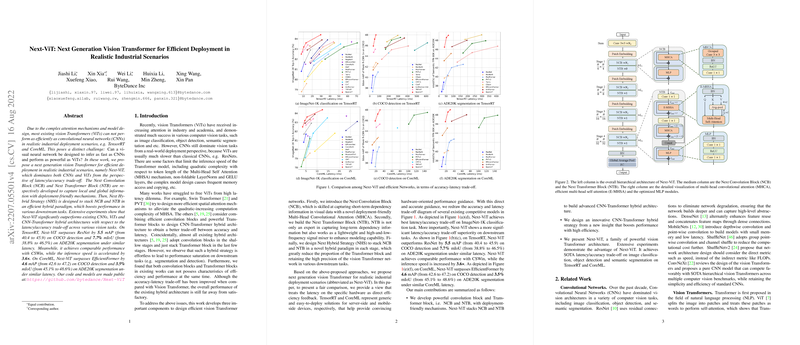Overview of "Next-ViT: Next Generation Vision Transformer for Efficient Deployment in Realistic Industrial Scenarios"
Vision Transformers (ViTs) have demonstrated significant success across a range of computer vision tasks, yet their complex architectures and demanding computational requirements have hindered efficient deployment in real industrial scenarios, particularly when compared to Convolutional Neural Networks (CNNs). This paper addresses this efficiency gap with the introduction of "Next-ViT," an innovative vision Transformer architecture that effectively balances the trade-off between latency and accuracy.
Key Innovations:
The paper introduces several core components aimed at enhancing both computational efficiency and performance:
- Next Convolution Block (NCB): Designed to capture local features efficiently, the NCB utilizes a novel Multi-Head Convolutional Attention (MHCA) mechanism. This design choice maintains deployment-friendly operations while improving performance comparable to traditional Transformer blocks.
- Next Transformer Block (NTB): The NTB complements the NCB by capturing global and long-term dependencies. It integrates Efficient Multi-Head Self Attention (E-MHSA) and MHCA to blend multi-frequency information, significantly boosting model capabilities without sacrificing efficiency.
- Next Hybrid Strategy (NHS): The NHS strategically combines NCBs and NTBs across all network stages, unlike conventional methods that only concentrate Transformer blocks in the deeper layers. This strategy ensures a robust capture of both local and global features throughout the network, enhancing performance in downstream tasks like segmentation and detection.
Empirical Results:
Extensive evaluations demonstrate that Next-ViT achieves superior latency/accuracy trade-offs on multiple hardware platforms including TensorRT and CoreML. Notably, it outperforms existing CNNs, ViTs, and hybrid models across various datasets and tasks:
- On ImageNet-1K, Next-ViT outperforms several well-known models such as ResNet101 in terms of accuracy, while maintaining efficient inference speeds.
- For COCO detection and ADE20K segmentation, Next-ViT achieves significant improvements in both mAP and mIoU metrics under similar latency conditions.
- The model shows comparable performance to state-of-the-art Transformers like CSWin, but with substantially reduced inference times, verifying its practical applicability.
Broader Implications:
The implications of this work stretch across both theoretical and practical landscapes:
- Theoretically, the integration of multi-frequency signal processing in Transformers may inspire further research into hybrid architectures that can efficiently harness diverse feature representations.
- Practically, Next-ViT's deployment efficiency on diverse hardware platforms makes it a promising candidate for widespread use in mobile and server-based applications, potentially accelerating the adoption of Transformers in industry-grade applications.
Future Directions:
The Next-ViT framework opens several avenues for future exploration. Continued optimization of the Next Hybrid Strategy could refine the balance between computational demand and model performance. Moreover, extending Next-ViT's principles to other domains, such as natural language processing or even more specialized vision applications, may yield additional insights.
In summary, Next-ViT represents a meaningful step forward in the design of efficient, high-performance vision Transformers, providing valuable insights and tools for both academia and industry to deploy more capable models in practical scenarios.
